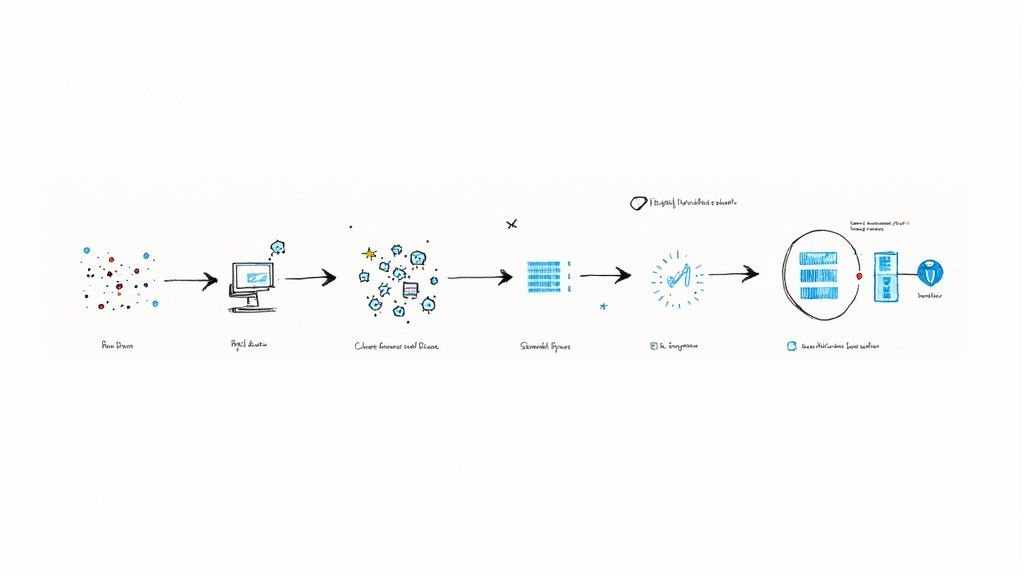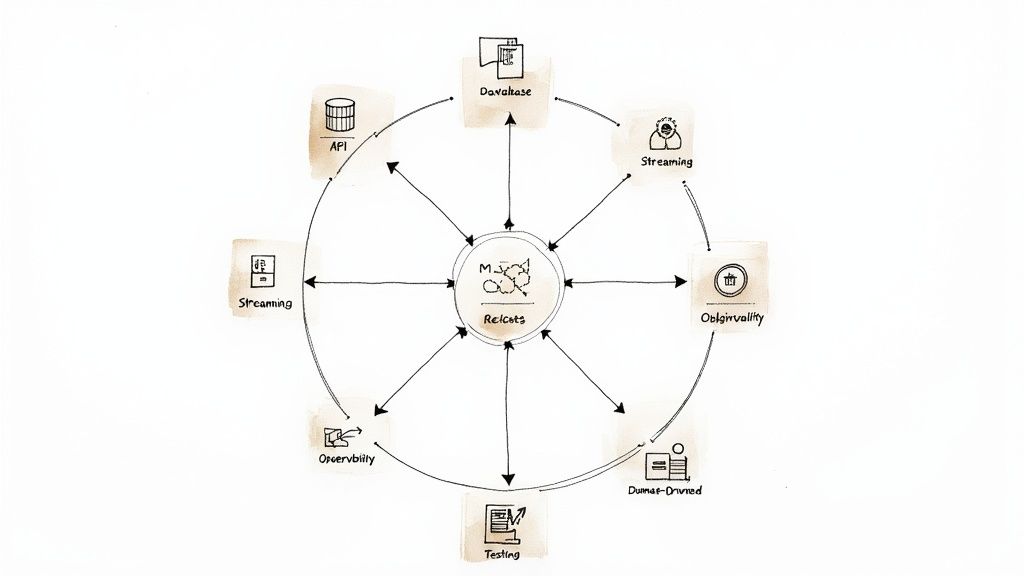Top 12 Database Synchronization Tools for 2025

Explore the best database synchronization tools for real-time data movement. Our 2025 guide covers features, pros, cons, and use cases to help you choose.
In a data-driven environment, the delay between data creation and its availability for analysis translates directly into missed opportunities and flawed business intelligence. Traditional batch ETL processes, once the industry standard, are now a significant source of operational friction, creating costly information gaps. The competitive edge belongs to organizations that can act on information as it happens, not hours or days later.
This shift demands a modern approach: real-time data movement powered by database synchronization tools. These platforms leverage Change Data Capture (CDC) to stream updates from transactional databases like Postgres and MySQL to data warehouses, analytics platforms, and operational applications as they occur. This ensures that every part of your data ecosystem, from customer-facing apps to executive dashboards, operates with the most current and accurate information available.
Making the right choice, however, is critical. The market is filled with solutions ranging from managed cloud services to powerful self-hosted platforms, each with distinct architectures, pricing models, and performance characteristics. A tool that excels at migrating a simple workload to the cloud might struggle with a complex, high-throughput replication scenario.
This comprehensive guide cuts through the marketing noise to provide a detailed, practical overview of the 12 leading database synchronization tools. We go beyond feature lists to offer a clear-eyed assessment of each platform’s strengths, weaknesses, and ideal use cases. You will find screenshots, direct links, and actionable insights to help you identify the best solution for your specific technical and business requirements, whether you're building a real-time analytics pipeline, ensuring high availability, or modernizing your data infrastructure.
1. Streamkap
Streamkap establishes itself as a premier choice among modern database synchronization tools by delivering high-performance, real-time data movement with a zero-operations approach. It specializes in sub-second Change Data Capture (CDC), allowing organizations to move beyond slow, batch-oriented ETL processes. This enables continuous, low-latency data synchronization from sources like PostgreSQL, MySQL, and MongoDB directly to destinations such as Snowflake, Databricks, and BigQuery.

The platform is engineered to remove the significant operational overhead typically associated with managing real-time data pipelines. By handling complex infrastructure like Kafka and Flink behind the scenes, Streamkap empowers data teams to stand up robust, event-driven workflows in minutes, not weeks. This focus on operational simplicity, combined with powerful features, makes it a compelling solution for businesses aiming to build real-time analytics dashboards, power AI/ML models with fresh data, or synchronize operational systems without impacting source database performance.
Key Features and Analysis
- Sub-Second CDC: At its core, Streamkap excels at capturing database changes with minimal latency, ensuring destination systems are always up-to-date. This is critical for use cases requiring immediate data access.
- Automated Schema Drift Handling: The platform automatically detects and propagates schema changes from source to destination, preventing pipeline failures and eliminating a common source of manual maintenance.
- Built-in Transformations: Users can apply transformations directly within the pipeline using Python or SQL, simplifying data cleansing, enrichment, and formatting without needing a separate processing layer.
- Production-Ready Operations: With automatic scaling, built-in monitoring and alerting, and auto-recovery mechanisms, Streamkap is designed for mission-critical workloads. Its responsive Slack-based support further enhances its production reliability.
Pros and Cons
Website: https://streamkap.com
2. Quest Software – SharePlex
Quest Software’s SharePlex is an enterprise-grade database synchronization tool specifically engineered for high-stakes Oracle and PostgreSQL environments. It excels at providing near real-time, low-impact data replication, making it a go-to solution for organizations that cannot afford downtime or data loss. Unlike more generalized tools, SharePlex focuses deeply on these two database ecosystems, offering mature and robust features for complex scenarios.
Its primary function is to capture changes from a source database's transaction logs and replicate them to one or more targets with minimal performance overhead. This capability is critical for use cases like high availability (HA), disaster recovery (DR), zero-downtime migrations, and offloading reporting workloads to secondary systems.

Key Features and Use Cases
SharePlex stands out with its proven active-active replication capabilities, complete with sophisticated conflict resolution mechanisms. This allows for geographically distributed databases to remain synchronized while both are actively serving write traffic, a complex challenge few tools handle as reliably.
- Heterogeneous Replication: While its core strength is Oracle/PostgreSQL, it can replicate data to a wide array of targets, including SQL Server, Kafka, Snowflake, and major cloud platforms.
- Built-in Utilities: The platform includes integrated tools for monitoring replication health, comparing data sets for consistency, and repairing any out-of-sync data.
- Implementation Tip: When setting up for a migration, use the data comparison utility post-initial load to verify data integrity before the final cutover. This ensures a seamless transition without data discrepancies.
Pricing and Access
Pricing for SharePlex is available by quote only, as it's tailored to specific enterprise needs, such as the number of CPUs on source and target servers. Access is provided directly through Quest's sales and support channels.
Website: https://www.quest.com/products/shareplex/
3. Qlik – Qlik Replicate
Qlik Replicate is a universal data replication and ingestion platform designed for modern enterprise analytics. It stands out among database synchronization tools by offering broad, agentless connectivity and low-impact, log-based Change Data Capture (CDC) across an extensive range of sources. This includes RDBMS, mainframes, SAP, data warehouses, and streaming platforms. Its core strength lies in its ability to efficiently move data in real-time from operational systems to analytics and cloud environments with minimal overhead.
The platform is engineered to support the entire data pipeline, from initial ingestion to continuous updates, managed through a central console. This makes it a powerful choice for organizations building streaming data architectures or looking to feed real-time data into cloud data warehouses like Snowflake, BigQuery, or Synapse. To learn more about how this technology works, check out this guide on Change Data Capture tools.
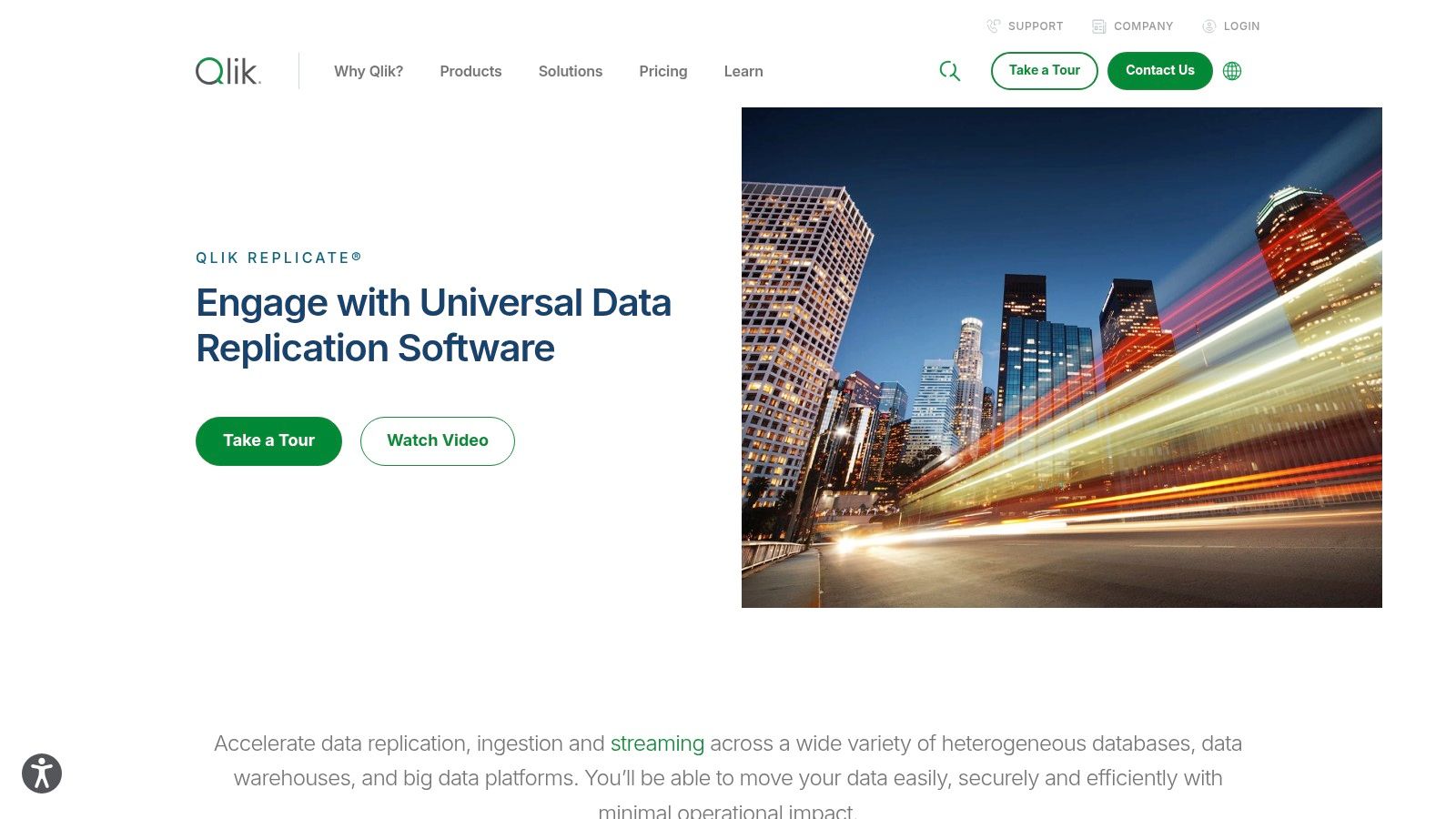
Key Features and Use Cases
Qlik Replicate's primary appeal is its user-friendly, no-code graphical interface that simplifies the configuration of complex replication tasks. This allows teams to set up data pipelines quickly without extensive manual scripting, accelerating time-to-value for analytics projects.
- Broad Heterogeneous Support: Replicates data from an extensive list of sources to nearly any major database, data warehouse, or streaming target.
- Performance and Scalability: Utilizes log-based CDC to minimize impact on source production systems and can be configured for real-time or optimized batch delivery.
- Implementation Tip: Use the intuitive graphical interface to prototype and test replication tasks quickly. The platform's real-time monitoring capabilities help identify and resolve bottlenecks before moving to production.
Pricing and Access
Qlik Replicate's pricing is quote-based and tailored to the specific environment, including the number and type of endpoints and data volume. Access is managed through Qlik’s direct sales team and its extensive partner network.
Website: https://www.qlik.com/us/products/qlik-replicate
4. Oracle – GoldenGate
Oracle GoldenGate is the company's flagship platform for real-time data integration and replication, widely regarded as a gold standard for mission-critical Oracle environments. It functions as a comprehensive change data capture (CDC) and replication solution, providing the backbone for high availability, disaster recovery, and near-zero downtime migrations. Its deep integration with the Oracle Database makes it an unparalleled choice for organizations heavily invested in that ecosystem.
GoldenGate is available both as a traditional on-premises licensed software and as a fully managed cloud service, OCI GoldenGate. This flexibility allows businesses to choose the deployment model that best fits their operational and financial strategy, whether they need full control on-prem or the agility of the cloud. The platform captures transactional changes from source databases and delivers them to targets with sub-second latency.

Key Features and Use Cases
GoldenGate excels in complex, high-volume scenarios, supporting bidirectional and multi-master replication configurations with robust conflict detection and resolution. Its ability to handle heterogeneous environments means it can replicate data not only between Oracle databases but also to and from a wide array of non-Oracle systems, including SQL Server, DB2, and various cloud data platforms.
- Real-time CDC and Replication: Captures and delivers data changes with minimal impact, ideal for feeding analytics platforms or synchronizing operational systems.
- Zero-Downtime Operations: Facilitates major database upgrades, platform migrations, and hardware refreshes without interrupting business applications.
- Cloud and On-Prem Flexibility: OCI GoldenGate offers a managed service experience, while the on-premises version gives enterprises maximum control over their infrastructure.
- Implementation Tip: For a cloud migration, start with the OCI GoldenGate managed service to quickly establish a replication pipeline and validate data flow before committing to a complex on-prem setup.
Pricing and Access
Pricing for Oracle GoldenGate is multifaceted. The managed OCI GoldenGate service is metered by OCPU/vCPU hour, offering a pay-as-you-go model. The on-premises software is licensed and typically requires engaging with Oracle's sales team for a custom quote based on deployment size and scope. Both models are detailed on Oracle’s website.
Website: https://www.oracle.com/integration/goldengate/pricing/
5. IBM – Data Replication (InfoSphere/IBM Data Replication)
IBM Data Replication is an enterprise-grade solution designed for real-time, low-latency data synchronization across diverse and complex IT landscapes. It specializes in connecting legacy mainframe systems with modern distributed and cloud databases, making it a cornerstone for organizations undergoing digital transformation. The platform provides continuous availability, disaster recovery, and the ability to unlock valuable mainframe data for modern analytics.
Its core strength lies in its change data capture (CDC) technology, which reads database logs to stream changes with minimal impact on source system performance. This makes it an ideal choice for businesses that need to maintain continuous operations while feeding data to analytics platforms, synchronizing hybrid cloud environments, or offloading workloads from critical production systems.
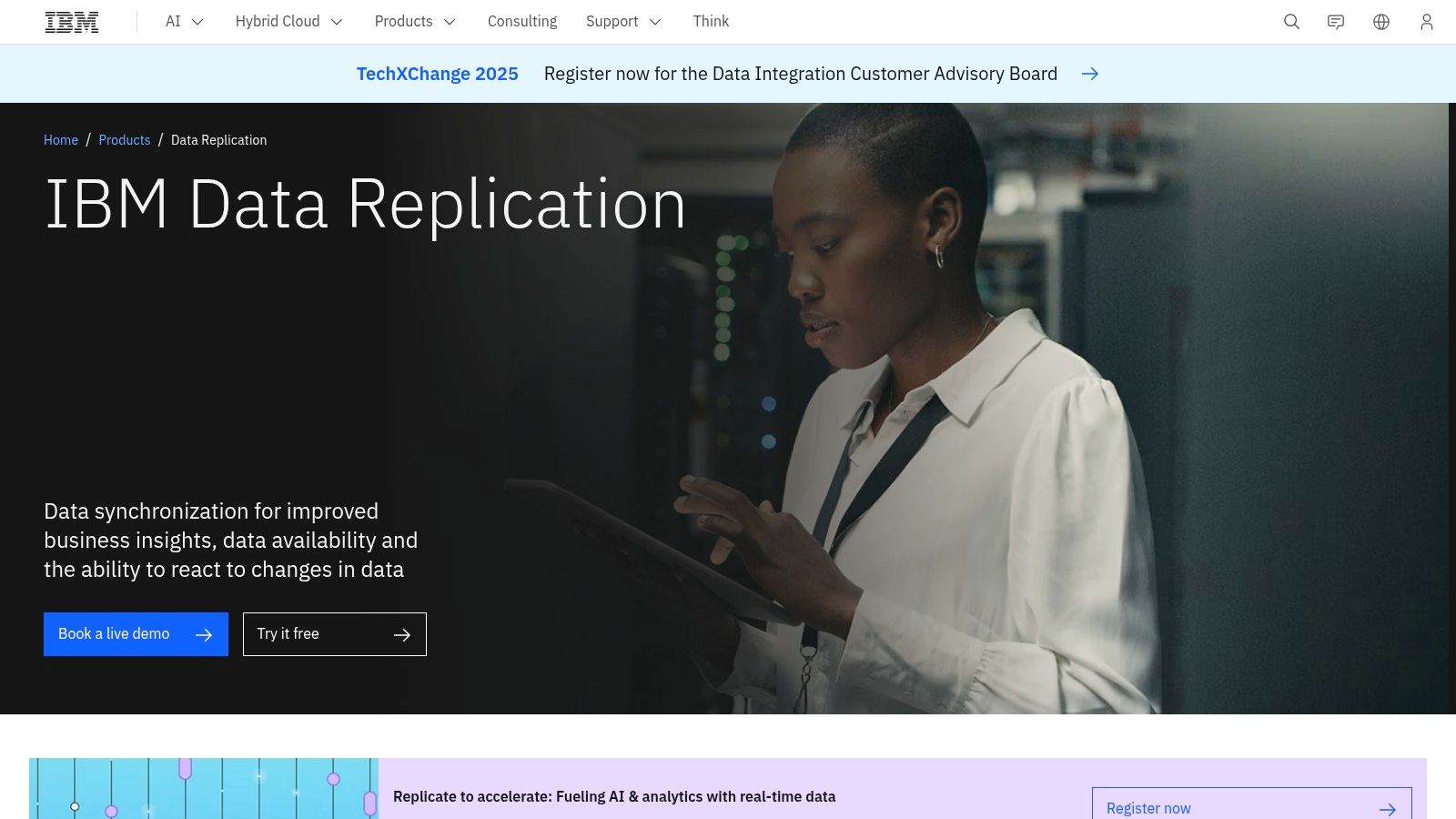
Key Features and Use Cases
IBM's tool stands out for its deep integration with mainframe systems like Db2 for z/OS, a capability few other database synchronization tools offer at this level. This allows heavily regulated industries such as finance and insurance to modernize their data architecture without abandoning their investment in mission-critical legacy infrastructure.
- Broad Connectivity: It supports CDC from sources like Db2, Oracle, and SQL Server, delivering data to targets including Kafka, Snowflake, and Google BigQuery.
- Streaming Integration: Natively integrates with modern streaming platforms like Kafka, enabling real-time analytics and event-driven architectures.
- Implementation Tip: When planning a mainframe data offload, start with a no-cost trial to validate CDC performance on your Db2 for z/OS environment and ensure target schema compatibility.
Pricing and Access
Pricing and licensing are handled directly through IBM's sales process and are customized based on the deployment scale and specific connectors required. IBM offers comprehensive product demos and no-cost trials to allow potential users to evaluate the platform's capabilities within their own environment.
Website: https://www.ibm.com/products/data-replication
6. Redgate – SQL Data Compare
Redgate’s SQL Data Compare is a highly focused and trusted tool designed for one specific job: comparing and synchronizing data between Microsoft SQL Server databases. Rather than offering broad, real-time replication, it provides an exact, row-level comparison and generates precise T-SQL scripts to resolve any differences. This makes it an indispensable asset for developers and database administrators working exclusively within the SQL Server ecosystem.
Its core function is to ensure data consistency across different environments, such as development, testing, and production. The tool simplifies tasks like populating test databases with production data, troubleshooting data corruption by comparing against a backup, or deploying data changes as part of a release pipeline. It is renowned for its speed, reliability, and user-friendly interface.
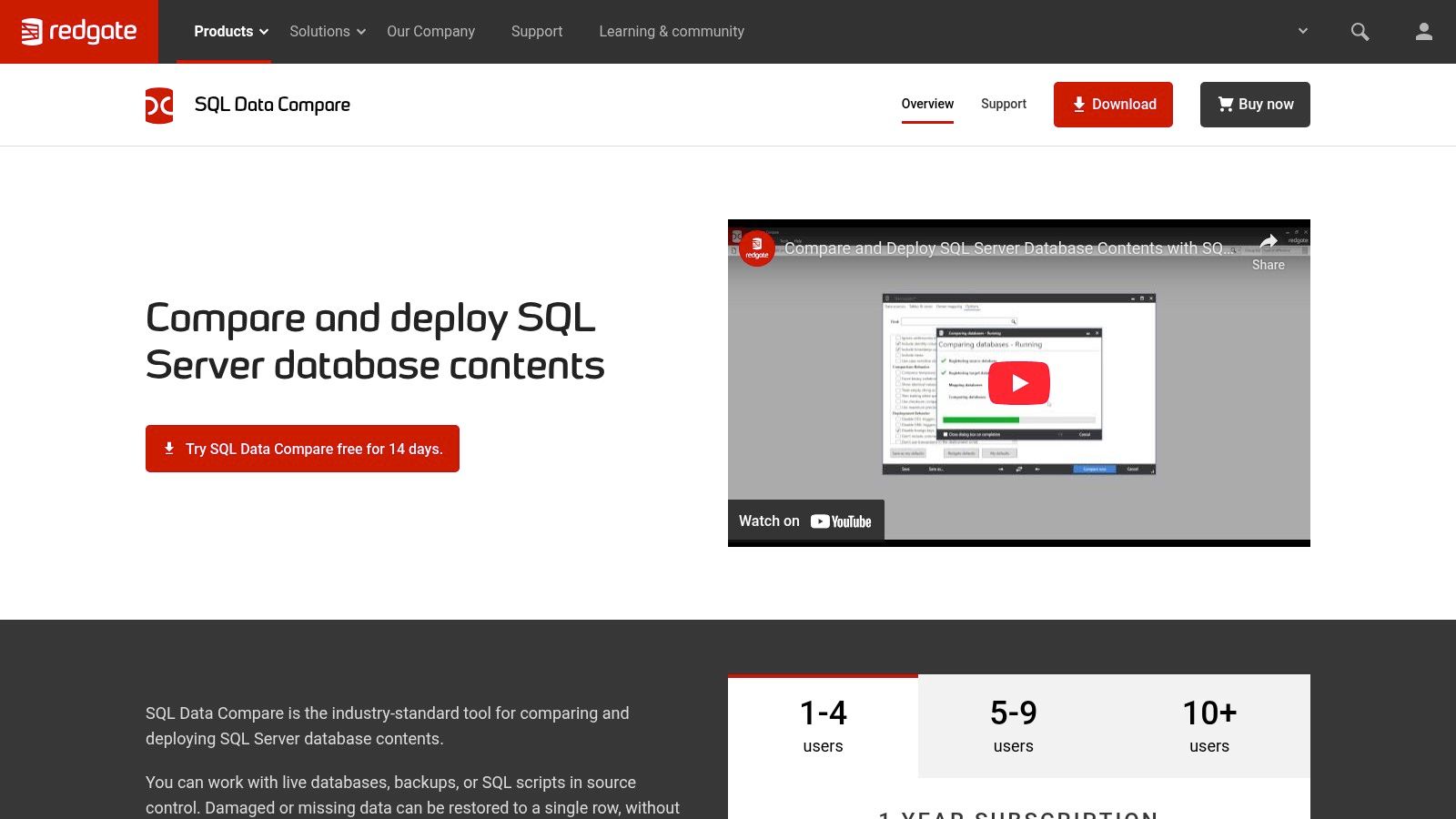
Key Features and Use Cases
SQL Data Compare's strength lies in its simplicity and deep integration with SQL Server workflows. It visually highlights differences and gives users granular control over which changes to deploy. This capability makes it one of the most practical database synchronization tools for environment alignment and manual data fixes.
- Script Generation: Generates error-free T-SQL deployment scripts that can be reviewed, edited, and executed to synchronize the target with the source.
- DevOps Integration: The Pro version includes a command-line interface, allowing for the automation of data comparisons and synchronizations within CI/CD pipelines.
- Implementation Tip: Before running a synchronization script on a production database, always generate the script first and execute it in a transaction within a test environment. This validates the changes and ensures there are no unintended consequences.
Pricing and Access
Redgate offers a 14-day free trial for SQL Data Compare. The tool can be purchased as a standalone product or as part of the comprehensive SQL Toolbelt. Pricing is per user, with different tiers available depending on the need for features like command-line automation.
Website: https://www.red-gate.com/products/sql-data-compare/
7. Fivetran – HVR (Self-Hosted/Local Data Processing)
Fivetran’s self-hosted solution, formerly known as HVR, is an enterprise-grade database synchronization tool designed for organizations requiring maximum control and performance. It specializes in high-volume, low-latency data replication using log-based Change Data Capture (CDC). Unlike fully managed SaaS platforms, this offering allows businesses to keep all data processing, credentials, and replication agents entirely within their own on-premises or private cloud environments, addressing strict security and compliance mandates.
Its distributed architecture is engineered to handle complex replication topologies with minimal impact on source systems. This makes it a powerful choice for hybrid cloud strategies, large-scale database migrations, and real-time analytics pipelines where data sovereignty is non-negotiable.
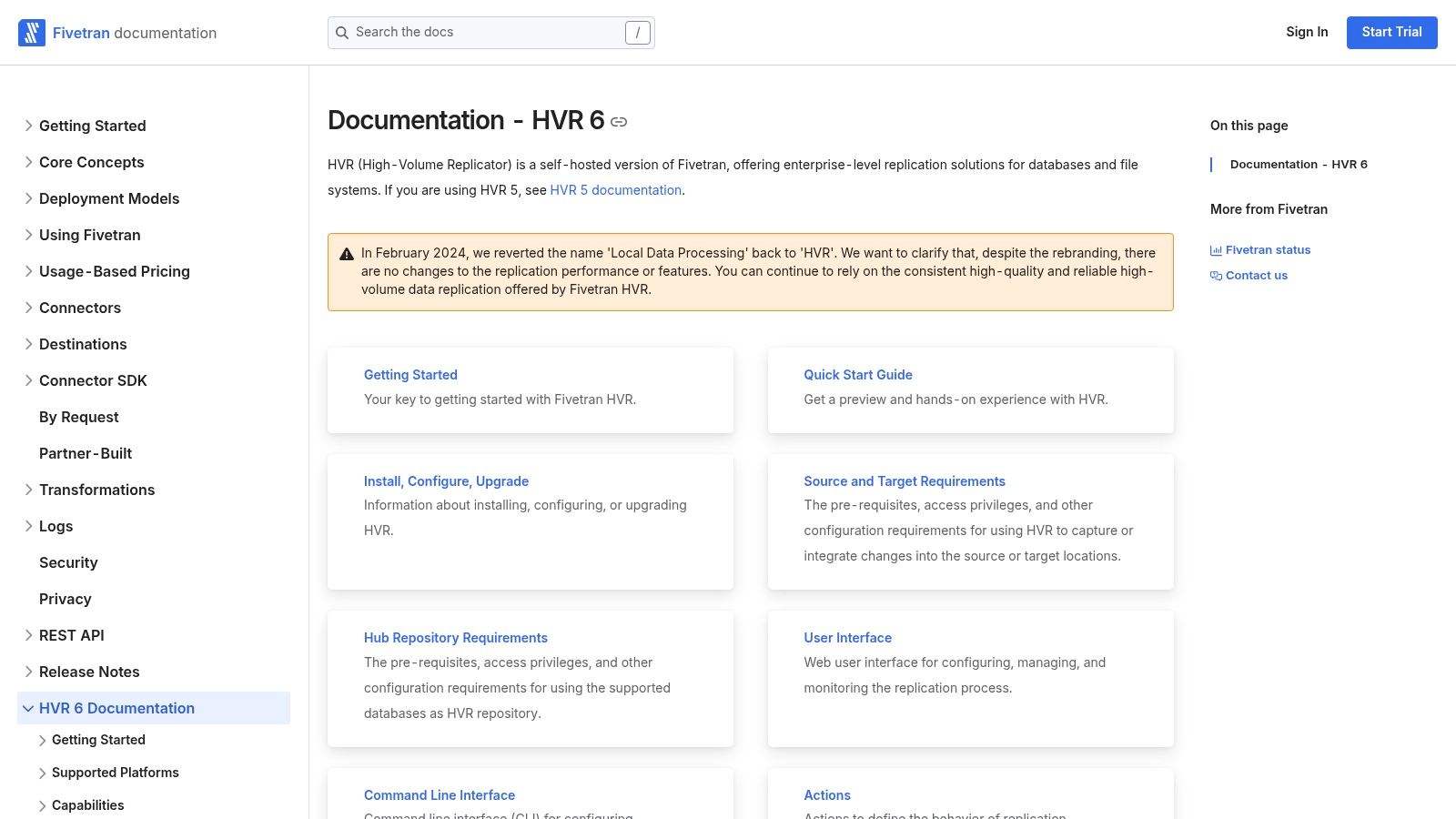
Key Features and Use Cases
Fivetran's self-hosted option excels with its distributed agent model, enabling high-throughput data movement across heterogeneous systems. It supports complex setups like broadcast, multi-hop, and bidirectional synchronization, providing flexibility for sophisticated data architectures.
- Log-Based CDC: Efficiently captures changes from a wide range of source databases, including Oracle, SQL Server, and Db2, ensuring near real-time data delivery.
- Flexible Topologies: Easily configure one-to-many, many-to-one, or cascaded replication streams to support diverse use cases from data warehousing to disaster recovery.
- Implementation Tip: When deploying in a hybrid environment, install HVR agents close to your source and target systems to minimize network latency and maximize data transfer speeds.
Pricing and Access
Pricing for the self-hosted solution is provided via a custom quote from the Fivetran sales team and is separate from their standard SaaS pricing model. Access to the software and enterprise-level support is managed directly through Fivetran after consultation.
Website: https://fivetran.com/docs/hvr6
8. SymmetricDS (JumpMind)
SymmetricDS by JumpMind is a powerful open-source database synchronization tool designed for flexibility and resilience. It specializes in cross-platform replication across heterogeneous database environments, making it a strong choice for businesses with diverse data stacks. Its ability to operate effectively over unreliable or low-bandwidth networks sets it apart, catering to distributed data architectures like retail point-of-sale (POS) systems or IoT device fleets.
The platform functions by capturing database changes asynchronously and pushing them to target nodes over standard web protocols like HTTP/S. This architecture is exceptionally tolerant of network interruptions, as data is queued and sent once connectivity is restored, ensuring eventual consistency. Its open-source core provides a cost-effective foundation, while a commercial Pro version offers enterprise-grade features and support.

Key Features and Use Cases
SymmetricDS excels at multi-master replication, where multiple nodes can accept writes and synchronize with each other. It provides robust data filtering and transformation capabilities, allowing you to control precisely which subsets of data are sent to specific nodes. For more information on how this technology works, you can explore the principles of real-time database synchronization.
- Broad Database Support: It supports a vast array of databases, including Oracle, MySQL, PostgreSQL, SQL Server, and many more, enabling seamless data flow between different systems.
- Resilient Data Transfer: Designed to work over WANs and unreliable connections, it's ideal for synchronizing data between a central office and hundreds or thousands of remote locations.
- Implementation Tip: For large-scale deployments, leverage the data routing and filtering features to create hub-and-spoke topologies. This minimizes network traffic by ensuring remote nodes only receive relevant data changes.
Pricing and Access
SymmetricDS is available in two tiers: a free, open-source Community Edition and a paid Pro Edition. The Pro version, which adds a management UI, clustering, enhanced security, and commercial support, is priced by quote based on the number of nodes.
Website: https://symmetricds.org/
9. AWS – Database Migration Service (AWS DMS)
AWS Database Migration Service (DMS) is a fully managed cloud service designed to simplify the migration of databases to AWS quickly and securely. While its primary purpose is migration, its powerful Change Data Capture (CDC) capabilities make it a strong contender among database synchronization tools, especially for one-time or phased data transfers into the AWS ecosystem. It handles the heavy lifting of provisioning, monitoring, and patching replication instances, allowing teams to focus on the migration itself rather than the underlying infrastructure.
DMS supports a wide variety of sources and targets, enabling heterogeneous migrations (like Oracle to Amazon Aurora) with minimal downtime. Its serverless option further simplifies operations by automatically scaling capacity up or down based on workload demand, making it a cost-effective choice for intermittent or unpredictable synchronization tasks.

Key Features and Use Cases
DMS excels at continuous data replication from an on-premises or cloud source to an AWS target during a migration cutover. This allows the source database to remain fully operational while the bulk data load and subsequent changes are synchronized. As solutions like AWS DMS are often used for initial data loads or continuous replication, understanding solid data migration best practices becomes essential for ensuring a smooth transition and reliable data flow.
- Wide Source/Target Support: Replicates data between most widely used commercial and open-source databases.
- Serverless Option: A "DMS Serverless" option is available that automatically provisions and scales migration resources.
- Implementation Tip: For large datasets, use the AWS Schema Conversion Tool (SCT) alongside DMS. SCT handles schema and code conversions, while DMS manages the actual data movement.
Pricing and Access
DMS offers a pay-as-you-go pricing model based on replication instance compute hours and storage usage. A free tier is available for a limited duration. The service is accessible directly from the AWS Management Console, providing a unified interface for setup and monitoring.
Website: https://aws.amazon.com/dms/pricing/
10. Microsoft Azure – SQL Data Sync
Microsoft Azure SQL Data Sync is a native cloud service designed for synchronizing data bidirectionally between Azure SQL databases and on-premises SQL Server instances. As a fully managed Platform as a Service (PaaS) offering, it simplifies the setup and maintenance of hybrid data architectures, making it one of the most accessible database synchronization tools for organizations already invested in the Microsoft ecosystem. It operates on a hub-and-spoke model, where a central "hub" database in Azure SQL synchronizes with various "member" databases, which can be other Azure SQL instances or on-premises SQL Servers.
This architecture is ideal for scenarios like synchronizing data from edge locations to a central hub, enabling geo-distributed applications with local data access, or facilitating gradual migrations from on-premises to the cloud. The entire service is configured and managed directly through the Azure portal, abstracting away the underlying complexity of replication agents and network configurations.

Key Features and Use Cases
SQL Data Sync is purpose-built for SQL Server and Azure SQL, offering deep integration and ease of use within that specific environment. It supports both unidirectional and bidirectional sync patterns, allowing for flexible data flow designs.
- Hybrid Synchronization: Its primary use case is creating a seamless data fabric between on-premises SQL Server and Azure SQL databases, supporting applications that span both environments.
- Managed Service: Configuration, scheduling, and monitoring are all handled via the Azure portal, PowerShell, or REST API, eliminating the need for dedicated infrastructure management.
- Implementation Tip: Pay close attention to the service limitations, such as the number of tables per sync group. For large databases, you may need to create multiple sync groups to cover all necessary tables, which requires careful planning.
Pricing and Access
Azure SQL Data Sync is a service provided at no additional cost. Users are only billed for the data movement charges associated with data transfer in and out of the Azure data center. Access is available to any user with an active Azure subscription through the Azure portal.
Website: https://azure.microsoft.com/en-us/blog/announcing-the-general-availability-of-azure-sql-data-sync/
11. Google Cloud – Datastream
Google Cloud's Datastream is a serverless, change data capture (CDC) and replication service built for simplicity and scale. It's designed to stream data changes from operational databases like Oracle and MySQL directly into Google Cloud destinations such as BigQuery, Cloud SQL, and Cloud Storage. As a fully managed service, it removes the complexity of provisioning and managing replication infrastructure.
Datastream focuses on providing a low-latency data pipeline, making it an excellent choice for organizations building real-time analytics dashboards or event-driven architectures within the Google Cloud ecosystem. It handles both the historical backfill and the ongoing CDC stream, ensuring a comprehensive and synchronized dataset at the target.
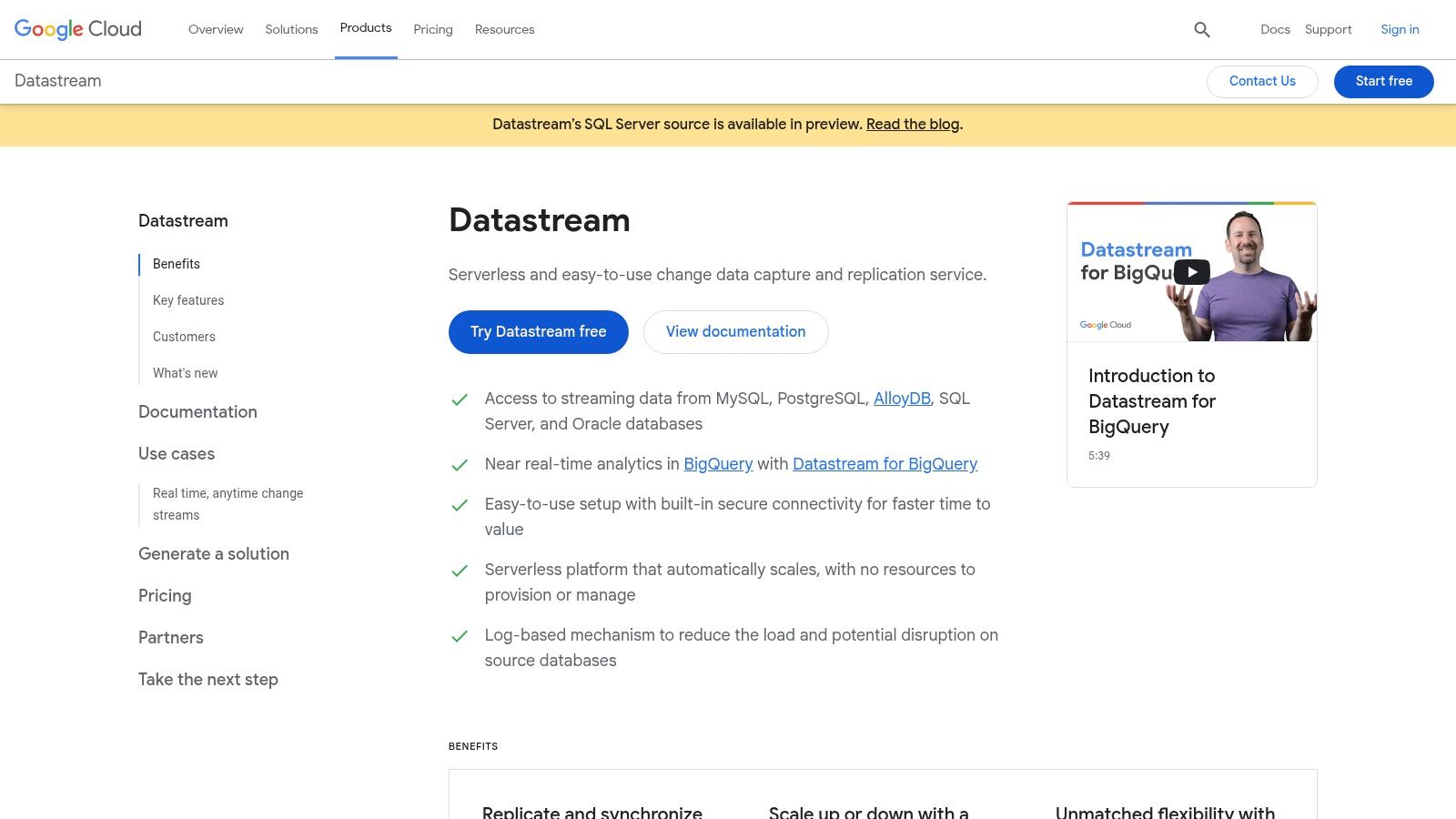
Key Features and Use Cases
The service's core value lies in its tight integration with Google's analytics stack, particularly BigQuery. This native connection simplifies the process of feeding live operational data into a data warehouse for immediate analysis, without the need for complex ETL scripts or third-party connectors.
- Serverless Architecture: Datastream is a fully managed, serverless platform, meaning users don't need to worry about server provisioning, capacity planning, or maintenance.
- Unified CDC and Backfill: It provides a single, seamless process for both the initial historical data load (backfill) and the continuous replication of new changes.
- Implementation Tip: Leverage Datastream's integration with Dataflow templates to perform in-flight transformations on your change stream before it lands in BigQuery, allowing you to clean, enrich, or reformat data on the fly.
Pricing and Access
Datastream uses a transparent, usage-based pricing model based on the gigabytes (GB) of data processed. The first 500 GiB of backfill data is free each month, making it cost-effective for smaller workloads. The service is accessible directly through the Google Cloud Console.
Website: https://cloud.google.com/datastream
12. EDB – Postgres Distributed (PGD, formerly BDR)
EDB Postgres Distributed (PGD) is an advanced, enterprise-grade logical replication solution designed specifically for demanding PostgreSQL environments. Formerly known as Bi-Directional Replication (BDR), PGD excels at creating highly available, geographically distributed database clusters. It enables write-anywhere mesh topologies, allowing applications to write to any node in the cluster while maintaining data consistency across all locations.
This powerful database synchronization tool is engineered for "Always On" architectures, providing continuous service even if an entire data center goes down. It handles this by offering robust conflict management and sophisticated commit controls, making it ideal for global applications requiring low-latency writes and high uptime. PGD is a core component of EDB’s enterprise subscription offerings, tailored for mission-critical systems.
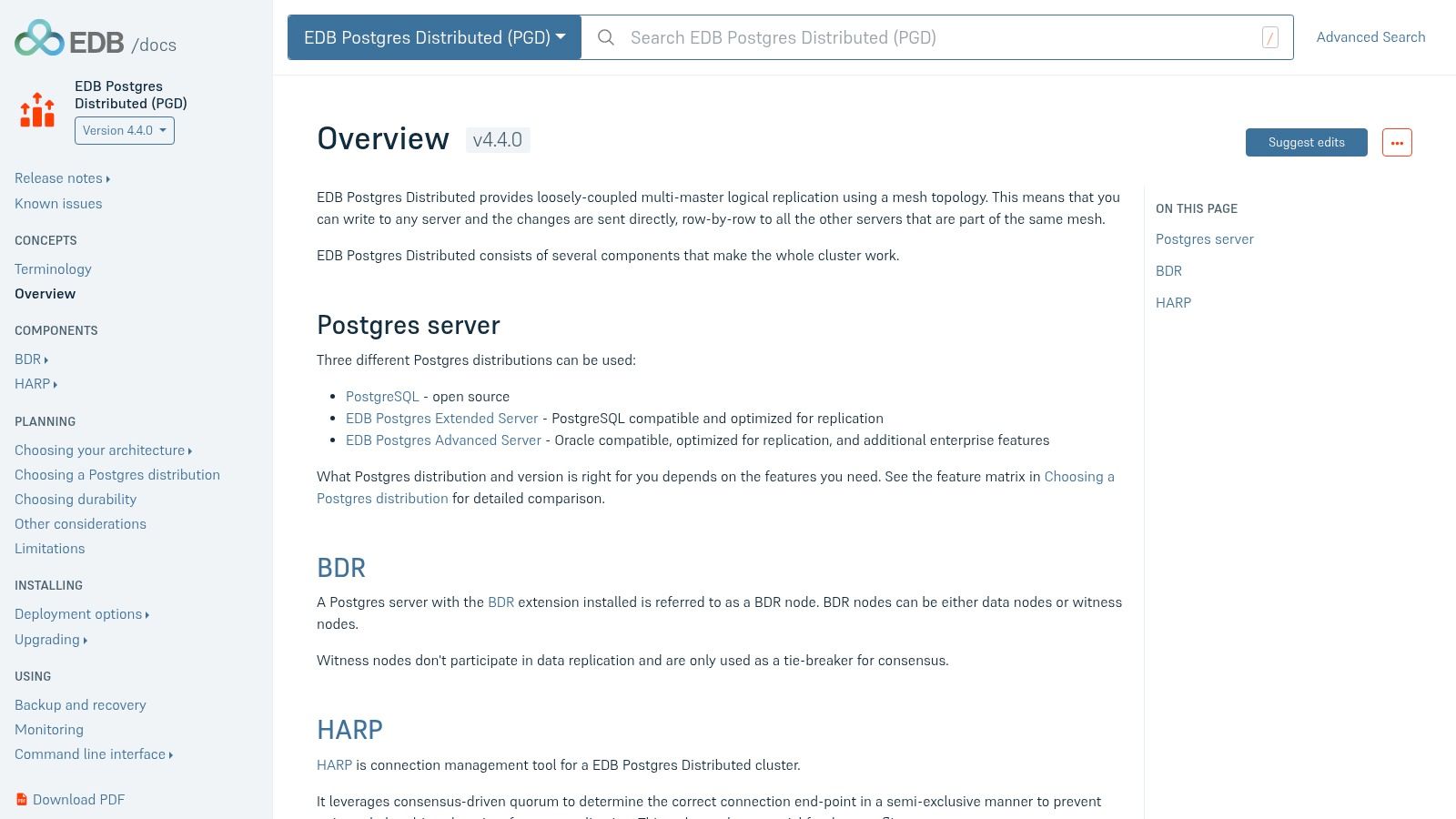
Key Features and Use Cases
PGD’s primary strength lies in its mature multi-master replication, which surpasses the capabilities of native PostgreSQL logical replication. It delivers higher throughput and provides advanced features like commit scopes (e.g., group commit) to ensure transactional consistency across geographically separate nodes. This makes it a leading choice for global write-intensive workloads.
- Multi-Master Mesh Topology: Allows any node in the distributed cluster to accept write operations, with built-in conflict detection and resolution.
- High Availability: Provides automated failover and switchover capabilities, ensuring business continuity with minimal disruption.
- Implementation Tip: Leverage PGD's reference architectures and EDB's expertise during the planning phase. Proper design of your conflict resolution strategy is critical for a successful distributed deployment.
Pricing and Access
Access to EDB Postgres Distributed is provided through an EDB enterprise subscription. Pricing is quote-based and tailored to the deployment scope. It is not available as a standalone open-source tool and requires engaging with the EDB sales team for a solution tailored to your architectural needs.
Website: https://www.enterprisedb.com/docs/pgd/4.4/overview/
Top 12 Database Synchronization Tools — Feature Comparison
Making the Right Choice for Your Data Architecture
Navigating the landscape of database synchronization tools can feel overwhelming, but the extensive list we've explored illuminates a clear path forward. Your journey from a monolithic data structure to a distributed, real-time architecture is not just possible, it's more accessible than ever before. We've seen how legacy powerhouses like Oracle GoldenGate and IBM Data Replication continue to offer robust, enterprise-grade solutions, while cloud-native services from AWS, Microsoft Azure, and Google Cloud provide tightly integrated options for those committed to a specific ecosystem.
The key takeaway is that there is no single "best" tool, only the one that best aligns with your unique architectural, operational, and financial requirements. Making the right choice hinges on a thorough evaluation of your specific needs against the capabilities of these platforms. The decision you make today will profoundly impact your data agility, operational overhead, and ability to scale in the future.
Key Factors to Guide Your Decision
Before committing to a solution, it's crucial to distill your requirements into a clear checklist. This strategic approach ensures you select a tool that not only solves your immediate problem but also supports your long-term data strategy.
Consider these critical evaluation criteria:
- Latency and Performance: Do you require sub-second, real-time data replication for analytical dashboards and operational systems, or is near-real-time with a few minutes of latency acceptable? Tools like Streamkap are engineered for ultra-low latency, while batch-oriented or less performant tools might suffice for less critical use cases.
- Operational Overhead: Evaluate your team's capacity to manage complex infrastructure. Managed services like Fivetran, cloud provider tools (AWS DMS), and modern platforms like Streamkap significantly reduce the burden of managing connectors, scaling infrastructure, and ensuring uptime compared to self-hosted solutions like SymmetricDS or complex setups like GoldenGate.
- Scalability and Data Volume: Your chosen tool must handle not only your current data volume but also your projected growth. Assess how each platform scales. Does it require manual intervention and server provisioning, or does it offer an elastic, auto-scaling architecture?
- Source and Destination Support: The diversity of your data ecosystem is a major factor. Ensure your top candidates offer robust, well-maintained connectors for all your critical sources (e.g., PostgreSQL, MongoDB, Oracle) and destinations (e.g., Snowflake, BigQuery, Kafka).
- Total Cost of Ownership (TCO): Look beyond the sticker price. A seemingly cheap solution can become expensive when you factor in engineering time for setup and maintenance, infrastructure costs (like managing a separate Kafka cluster), and the opportunity cost of data delays.
Actionable Next Steps for Your Team
With this comprehensive overview of the top database synchronization tools, you are now equipped to move forward with confidence. The next logical step is to transition from research to hands-on evaluation.
- Shortlist Your Candidates: Based on the criteria above, select two to three tools from this list that most closely match your needs.
- Initiate a Proof of Concept (PoC): There is no substitute for real-world testing. Set up a trial or a PoC with your shortlisted vendors using a representative, non-production dataset. This will reveal the true performance, ease of use, and support quality of each solution.
- Validate Against Your Use Case: During the PoC, rigorously test the tool against your primary synchronization scenario. Can it handle your data types? Does it meet your latency SLAs? How intuitive is the transformation and error-handling process?
Choosing the right database synchronization tool is a foundational decision that empowers your organization to unlock the full value of its data. By investing the time in a careful and methodical selection process, you build a resilient, scalable, and efficient data pipeline that will serve as a competitive advantage for years to come.
Ready to experience real-time data synchronization without the complexity and cost of managing Kafka? Streamkap offers a modern, fully managed platform built for ultra-low latency and infinite scalability. See how you can set up a production-ready pipeline in minutes by starting your free trial at Streamkap.


